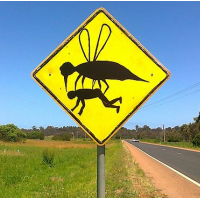Record Number of West Nile Deaths in 2014 Linked to Climate Change

Although the advantages of climate change have yet to come into clear focus, the list of disadvantages grows daily.
Last week, the California Department of Public Health (CDPH) announced a record 31 deaths in 2014 from West Nile Virus out of 801 cases, the second-highest number ever. California had 379 cases in 2013 and just 111 in 2010. The record was 880 cases in 2005.
The new numbers confirm a prediction by UCLA researchers in February 2014 that climate change would dramatically increase West Nile in the state. “In California, we estimate approximately 68 percent of the state's area will have an increase in the probability of West Nile virus by 2050,” Ryan Harrigan, a collaborator on the report (pdf), said at the time.
The study, from the Center for Tropical Research at UCLA's Institute of the Environment and Sustainability, was based on 10 years of data and said to be the first risk assessment of the virus.
State Health Officer and CDPH Director Dr. Karen Smith concurs. “It is possible that the ongoing drought contributed to West Nile virus activity by creating more limited sources of water for birds and mosquitoes,” she said on the department website.
Humans and animals get West Nile from mosquito bites. Most people who get the virus don’t get too sick. But 1% can develop a serious neurological illness, like encephalitis or meningitis. People over 50, diabetics and folks with high-blood pressure are most at risk of serious complications.
The CDPH also recorded the highest infection rate ever among mosquitoes—and dead birds. Dr. Smith speculated that, “As birds and mosquitoes sought water, they came into closer contact and amplified the virus, particularly in urban areas. The lack of water could have caused some sources of water to stagnate, making the water sources more attractive for mosquitoes to lay eggs.”
As of April 10, the official state West Nile website had not recorded any human cases in 2015. The season usually kicks in around June. But February is the new June climatewise in California, and there have already been virus detections in five dead birds and two mosquito pools.
The 2014 UCLA report predicted, “The disease will spread northward into previously unaffected areas.” Orange County had the most West Nile cases last year, 263, followed by Los Angeles County at 253. Fresno County, further north, was next at 43. The county had eight the year before.
–Ken Broder
To Learn More:
Record Number of West Nile Deaths Strike California in 2014 (by Christopher Weber, Associated Press)
West Nile Deaths in California Hit Record High in 2014 (by Susan Abram, Los Angeles Daily News)
Thanks to Climate Change, West Nile Virus Could Be Your New Neighbor (by Bryan Walsh, Time)
Is West Nile Virus Coming to Your Town? UCLA Releases First Risk-Assessment Predictions (by Rebecca Kendall, UCLA Newsroom)
California Sets Record for West Nile Virus Activity (California Department of Public Health)
- Top Stories
- Controversies
- Where is the Money Going?
- California and the Nation
- Appointments and Resignations
- Unusual News
- Latest News
- California Forbids U.S. Immigration Agents from Pretending to be Police
- California Lawmakers Urged to Strip “Self-Dealing” Tax Board of Its Duties
- Big Oil’s Grip on California
- Santa Cruz Police See Homeland Security Betrayal in Use of Gang Roundup as Cover for Immigration Raid
- Oil Companies Face Deadline to Stop Polluting California Groundwater





